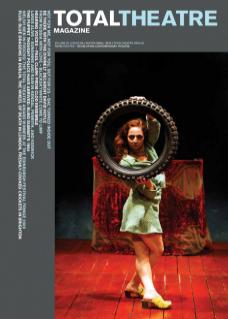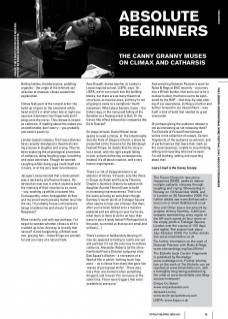Boiling kettles, thunderstorms, yodelling orgasms – the origin of the inherent satisfaction of dramatic climax needs little explanation.
Climax feels part of the natural order: the build-up of gack on the emotional whitehead until it’s a relief when late at night you squeeze it between two fingernails and it pings onto the mirror. This release is known as catharsis. If reading about this makes you uncomfortable, don’t worry – you probably just need a good cry.
London-based company The Fiasco Division have recently developed a theatrical training process in laughter and crying. They’ve been exploring the physiological processes of catharsis, doing laughing yoga, breathing and voice exercises. Though be warned: Laughing whilst doing yoga could itself end in tears, or at the very least incontinence.
Jacques Lecoq insisted that a denouement was a necessity of effective theatre. He devised an exercise in which students build the intensity of their reaction to an event – say, washing up whilst a tsunami hits. Consequently, when Armageddon strikes and my street starts pissing molten lava into the sky, I’ll probably freeze until someone bangs a tambourine and shouts ‘C’est six! Reagissez!’
More recently, and with age perhaps, I’ve begun to wonder whether climax is all it’s cracked up to be. Anyway, is it really that natural? A tree burgeoning, a British summer, greying hair – these things are wonderful and are more of a natural fade.
Amy Russell, drama teacher at London’s Lecoq inspired school, LISPA, says: ‘At LISPA, we’re very much into the building blocks, but there are as many theatrical structures as musical ones, and they’re not all going to come to a symphonic fourth movement. What about Eastern music – the Indian raga, or the rising and falling of the Gamelan at a Topeng event in Bali. Or the trance-like effect induced by companies like De la Guarda?’
On stage at least, Daniel Kitson never seems to need a climax. In The Interminable Suicide Note of Gregory Church, a show he presented at the Traverse for the Edinburgh Festival Fringe, he insists that his story is not a novel, with the right people falling in love, actions delivering consequences. Instead, it’s all about inaction, and a very human ongoingness...
There’s a risk of disappointment in an absence of climax. Virtuosic acts like those in Cirque du Soleil and Victoria Thierrée Chaplin’s Aurelia’s Oratorio (created with daughter Aurelia Thierre) have to build in increasing impressiveness. That’s not the same as being an anticlimax though. Gormley’s fourth plinth at Trafalgar Square often seems to host one of those. But then, after you’ve been hoiked onto a massive pedestal and are sitting on your toy horse, what more is there to do for an hour than wave to your friends below? (Perhaps that is the point, to remind us that we are small and ordinary…)
There’s power in deliberately denying climax (as opposed to failing to rustle one up) and perhaps it’s not the only way to achieve catharsis. Alexander Roberts (of the aforementioned Fiasco Division company) cites Gob Squad’s Kitchen – a recreation of a Warhol film in which ‘nothing much happens’ – as a climax-free show that gave him ‘waves of perceptual shifts’. ‘There was more than one moment when something dropped, and it wasn’t for everyone at the same time. There were triggers that were available to everyone.’
And watching Deborah Pearson’s work for Rules & Regs at BAC recently – a journey into a British bunker, that turns out to be a nuclear bunker, that turns out to be sponsored by the BNP – that step-by-step altering of our awareness, inching us further and further forward in our discomfiture – was itself a kind of build that needed no great crescendo.
Or perhaps giving the audience release is not as interesting as not releasing them? Tim Etchells of Forced Entertainment writes in his collection of essays, Certain Fragments, of the audience as witness, and of performances that leave their mark on the consciousness, ‘unable to stop thinking, talking and reporting what we’ve seen’. I’m still thinking, talking and reporting about that.
The Fiasco Division’s new piece Happiness [END], seeks to induce multiple cathartic climaxes through laughing and crying. Showcasing in Norway on 13 November 2009, and in London on 20 November 2009. For further details see www.thefiascodivision.com or email tfd@hotmail.co.uk
One and Other was a live artwork by sculptor Antony Gormley. 2,400 participants representing every region of the UK each spend an hour alone on the empty plinth in Trafalgar Square, London over the course of 100 days and nights. The project took place July–October 2009. For further details see www.oneandother.co.uk
For further information on the work of Deborah Pearson with Rules & Regs: www.rulesandregs.org/bac09.html
Tim Etchells book Certain Fragments is published by Routledge: www.routledge.com. Further information on the work of Tim Etchells can be reached at www.timetchells.com, with a fortnightly blog being published by the artist at www.timetchells.com/blogsection/notebook/
Cirque Du Soleil: www.cirquedusoleil.com
Jacques Lecoq: www.ecole-jacqueslecoq.com
LISPA: www.lispa.co.uk

